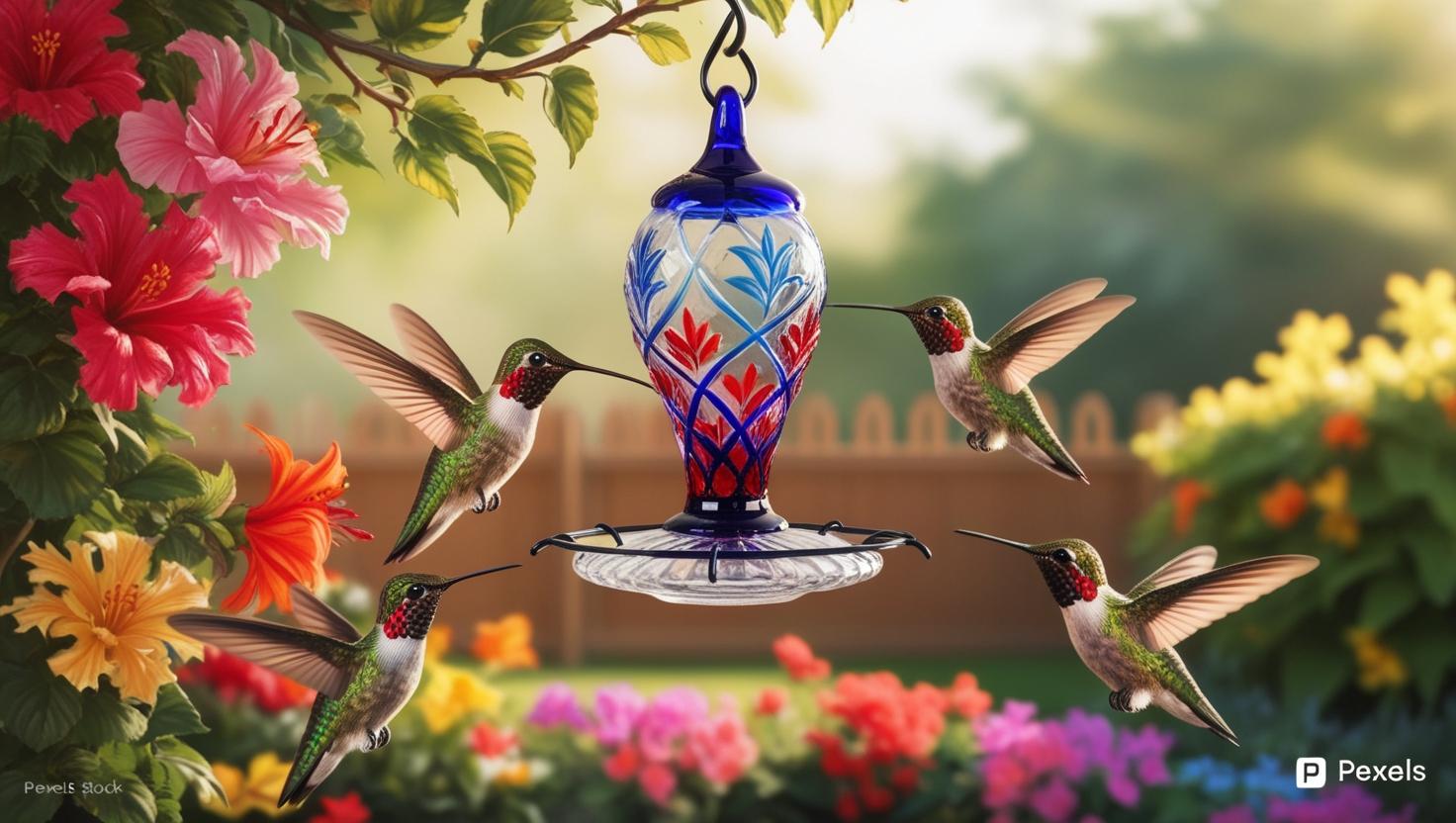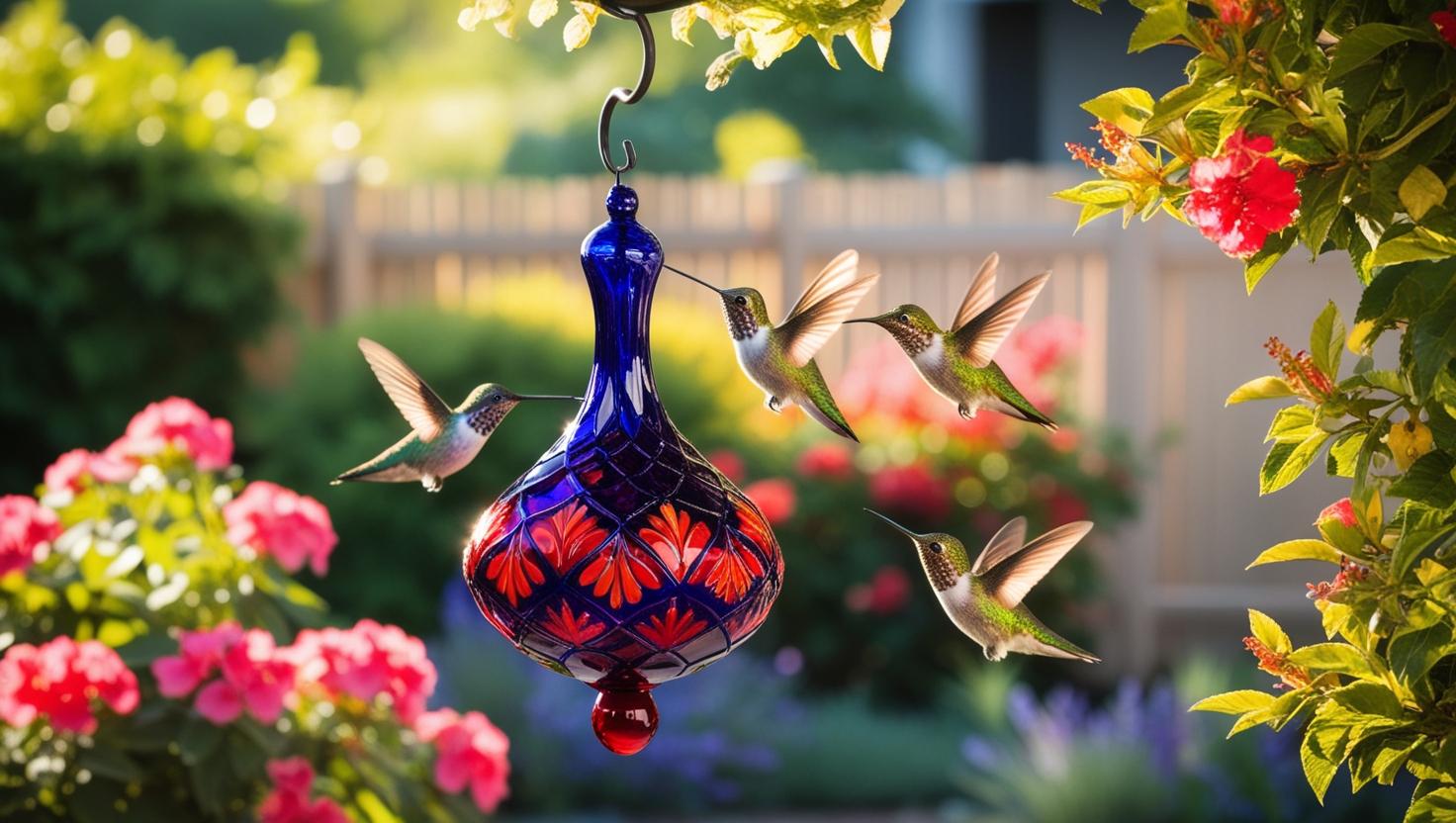A ceramic hummingbird feeder is a specialized bird feeder designed to attract hummingbirds by providing them with a reliable source of nectar. Unlike traditional feeders made from plastic or glass, ceramic feeders offer a unique aesthetic appeal, often featuring intricate designs and vibrant colors that complement garden settings. These feeders are not only functional but also serve as decorative elements, enhancing the visual appeal of outdoor spaces.
What a Ceramic Hummingbird Feeder Is
At its core, a ceramic hummingbird feeder consists of a ceramic reservoir that holds nectar, multiple feeding ports where hummingbirds can access the nectar, and usually a perching area. The ceramic material is chosen for its durability, aesthetic versatility, and ability to keep the nectar cool, which is essential for maintaining its freshness.
Materials Used to Make Ceramic Hummingbird Feeders
Ceramic hummingbird feeders are crafted from high-quality, non-toxic materials to ensure the safety of the birds and the longevity of the feeder. The primary materials include:
- Ceramic Clay: The base material, selected for its durability and ability to retain the nectar without reacting chemically.
- Glaze: Applied to the ceramic to provide a smooth, water-resistant finish. Glazes also allow for a variety of colors and patterns, enhancing the feeder’s decorative appeal.
- Metal Components: Stainless steel or copper are commonly used for parts like feeding ports and perch stands to prevent rusting and ensure durability.
- Seals and Caps: Made from food-grade silicone or other non-toxic materials to prevent leakage and contamination of the nectar.
Step-by-Step Process of How Ceramic Hummingbird Feeders Are Made
Creating a ceramic hummingbird feeder is an artisanal process that combines traditional craftsmanship with modern techniques. Here’s a step-by-step overview:
- Designing the Feeder: Artists and designers conceptualize the feeder’s shape, size, and decorative elements. Designs often incorporate vibrant colors and intricate patterns to mimic the natural beauty that attracts hummingbirds.
- Preparing the Clay: High-quality ceramic clay is kneaded and prepared to the right consistency, ensuring it is free of air bubbles and impurities that could weaken the structure.
- Forming the Body: The clay is shaped into the desired form using hand-building techniques or a pottery wheel. This includes creating the reservoir, feeding ports, and perching areas.
- Drying: The shaped clay is left to dry partially to a leather-hard state, where it is firm yet still pliable for detailed work.
- Adding Decorative Elements: Intricate patterns, textures, and additional decorative pieces are applied to the feeder at this stage. This may include mosaic tiles, hand-painted designs, or sculpted elements.
- Bisque Firing: The feeder undergoes its first firing in a kiln at a lower temperature to harden the clay, making it ready for glazing.
- Glazing: A glaze is applied to the feeder to add color and create a protective, water-resistant surface. Multiple layers may be applied for depth and durability.
- Glaze Firing: The glazed feeder is fired again in the kiln at a higher temperature, causing the glaze to melt and form a smooth, glass-like surface.
- Quality Inspection: Each feeder is meticulously inspected for defects, ensuring that it is both functional and aesthetically pleasing.
- Assembly: Metal components and seals are attached to the ceramic body, completing the feeder. The final product is then packaged for distribution.
Features of Ceramic Hummingbird Feeders
| Feature | Description |
|---|---|
| Durable Construction | Made from high-quality ceramic and metal components, ensuring longevity and resistance to weather elements. |
| Aesthetic Design | Intricate patterns, vibrant colors, and decorative elements that enhance garden and outdoor aesthetics. |
| Nectar Reservoir | Designed to hold nectar securely, often with a capacity that minimizes frequent refills. |
| Feeding Ports | Multiple feeding ports allow several hummingbirds to feed simultaneously, reducing competition and ensuring ample access to nectar. |
| Perch Stands | Equipped with perches or hooks for hummingbirds to rest while feeding, providing a comfortable and safe feeding experience. |
| Easy to Clean | Designed for easy disassembly and cleaning, preventing mold and bacterial growth which can harm hummingbirds. |
| Weather Resistant | Glazed surfaces protect against rain, sun, and freezing temperatures, maintaining the feeder’s integrity and functionality year-round. |
| Eco-Friendly Materials | Made from non-toxic, environmentally friendly materials that are safe for birds and the surrounding ecosystem. |
| Customizable Options | Available in various sizes, shapes, and designs to match different garden themes and personal preferences. |
| Secure Sealing | Features secure seals to prevent nectar leakage, attracting hummingbirds without creating messes in the garden. |
Benefits and Value of Ceramic Hummingbird Feeders
| Benefit | Value |
|---|---|
| Enhanced Aesthetic Appeal | Adds a decorative element to gardens, complementing plants and outdoor decor with vibrant colors and unique designs. |
| Attracts More Hummingbirds | The design and nectar quality effectively attract a variety of hummingbird species, increasing sightings and birdwatching enjoyment. |
| Durability and Longevity | Resistant to weather conditions, reducing the need for frequent replacements and providing long-term use. |
| Healthier Nectar Storage | Ceramic material maintains nectar quality by keeping it cool and preventing the growth of harmful bacteria and mold. |
| Eco-Friendly Choice | Made from sustainable materials, promoting environmentally responsible birdwatching practices. |
| Easy Maintenance | Simple to clean and refill, ensuring a hassle-free experience for users and a safe feeding environment for hummingbirds. |
| Supports Bird Conservation | By providing a reliable food source, ceramic feeders contribute to the survival and well-being of hummingbird populations, especially in urban areas. |
| Versatile Placement | Suitable for various garden settings, balconies, patios, and outdoor spaces, enhancing their visual appeal wherever placed. |
| Customization and Personalization | Allows enthusiasts to choose feeders that reflect their personal style and garden theme, making each feeder unique. |
| Investment in Quality | Higher upfront cost is offset by the feeder’s durability and aesthetic value, offering long-term benefits and satisfaction. |
Care and Maintenance of Ceramic Feeders
Proper care and maintenance of your ceramic hummingbird feeder ensure the health of the hummingbirds and the longevity of the feeder itself. Here are essential maintenance tips:
- Regular Cleaning: Clean the feeder at least once a week, especially during warmer months, to prevent mold, bacteria, and yeast growth. Use a solution of hot water and vinegar or mild soap, ensuring all parts are thoroughly rinsed.
- Inspect for Damage: Regularly check for cracks or chips in the ceramic. Damaged feeders can harbor bacteria and may need repair or replacement.
- Change Nectar Frequently: Replace the nectar every few days, more often in hot weather, to maintain its freshness and prevent fermentation.
- Dry Completely: Allow all parts to dry completely before reassembling to prevent mold growth.
- Store Properly in Winter: In colder climates, consider storing the feeder indoors during winter months to prevent freezing and breakage.
- Check Seals and Caps: Ensure that all seals and caps are intact and functioning correctly to prevent leaks and contamination.
- Protect from Predators: Position the feeder away from areas where cats or other predators can easily reach it, ensuring the safety of hummingbirds.
Key Factors to Consider When Selecting or Buying Ceramic Hummingbird Feeders
When choosing a ceramic hummingbird feeder, several factors can influence your decision to ensure you select the best option for your needs:
- Design and Aesthetics: Choose a feeder that complements your garden’s aesthetic. Options range from traditional to modern designs with various colors and patterns.
- Capacity: Consider the nectar capacity based on the number of hummingbirds in your area. Larger feeders require less frequent refills but may take longer to dry.
- Ease of Cleaning: Opt for feeders that are easy to disassemble and clean. Smooth surfaces without intricate crevices are easier to maintain.
- Durability: Ensure the feeder is made from high-quality, weather-resistant materials that can withstand your local climate conditions.
- Feeding Ports: Look for feeders with multiple feeding ports to accommodate more birds and reduce competition.
- Perching Options: Some feeders come with built-in perches, while others rely solely on hovering. Choose based on your preference for observation.
- Price and Value: While ceramic feeders may be more expensive upfront, their durability and aesthetic value often provide better long-term value compared to cheaper alternatives.
- Eco-Friendliness: Select feeders made from non-toxic, environmentally friendly materials to ensure the safety of hummingbirds and the ecosystem.
- Warranty and Support: Consider brands that offer warranties or customer support, ensuring assistance if any issues arise with the feeder.
- Reviews and Recommendations: Research customer reviews and seek recommendations from other birdwatching enthusiasts to gauge the feeder’s performance and reliability.
Enhancing Your Garden with Decorative Hummingbird Feeders
Decorative hummingbird feeders not only attract these enchanting birds but also serve as artistic additions to your garden. The intricate designs and vibrant colors of ceramic feeders can complement various garden styles, from rustic to contemporary. By integrating a ceramic hummingbird feeder into your outdoor space, you create a focal point that draws attention and invites nature’s beauty right to your doorstep.
Conclusion
Investing in a ceramic hummingbird feeder is a rewarding decision for both novice and experienced birdwatching enthusiasts. These feeders offer a perfect blend of functionality and aesthetic appeal, providing a safe and attractive feeding spot for hummingbirds while enhancing the beauty of your garden. By understanding what a ceramic hummingbird feeder is, the materials and craftsmanship involved, and the benefits they offer, you can make an informed choice that enriches your outdoor experience and supports the vibrant hummingbird population.
Frequently Asked Questions (FAQs) Answered
- What makes ceramic hummingbird feeders better than plastic ones? Ceramic hummingbird feeders are more durable, aesthetically pleasing, and better at maintaining nectar quality. They are less likely to crack or fade over time and often feature intricate designs that enhance garden decor. Additionally, ceramic materials help keep the nectar cooler, preventing spoilage and reducing the need for frequent refills.
- How do I clean my ceramic hummingbird feeder effectively? To clean your ceramic hummingbird feeder, disassemble all parts and wash them with a solution of hot water and white vinegar or mild dish soap. Use a bottle brush to scrub all areas thoroughly, ensuring the removal of any mold or residue. Rinse all parts with clean water and allow them to dry completely before refilling with fresh nectar.
- Can ceramic hummingbird feeders withstand extreme weather conditions? Yes, ceramic hummingbird feeders are designed to be weather-resistant. The glazed ceramic surface protects against rain, sun, and freezing temperatures. However, in areas with severe weather, it’s advisable to regularly inspect the feeder for any damage and store it indoors during extreme conditions to prolong its lifespan.
- What type of nectar should I use in a ceramic hummingbird feeder? Use a homemade nectar solution made by mixing four parts water with one part white granulated sugar. Boil the mixture to dissolve the sugar and let it cool before filling the feeder. Avoid using honey, artificial sweeteners, or red food coloring, as these can be harmful to hummingbirds.
- How often should I refill and clean my ceramic hummingbird feeder? Refill the feeder with fresh nectar every two to three days, more frequently in hot weather to prevent fermentation. Clean the feeder thoroughly once a week, or more often if you notice mold or debris, to ensure the health and safety of the hummingbirds.
- Are ceramic hummingbird feeders safe for all hummingbird species? Yes, ceramic hummingbird feeders are safe for all hummingbird species. They provide a reliable source of nectar and are designed to be easy for hummingbirds to access. Ensure the feeding ports are appropriately sized for the species in your area to prevent spills and ensure efficient feeding.
- Where is the best location to place my ceramic hummingbird feeder? Place the feeder in a shaded area to keep the nectar cool and reduce evaporation. Position it near flowering plants or trees to provide a natural food source and shelter. Ensure it is visible from your home for easy birdwatching and placed away from windows to prevent collisions.
- Can I customize my ceramic hummingbird feeder? Yes, many ceramic hummingbird feeders come in various designs, colors, and patterns to match different garden styles. Some artisans offer customization options, allowing you to select specific colors or add personalized decorations to your feeder.
- How long do ceramic hummingbird feeders typically last? With proper care and maintenance, ceramic hummingbird feeders can last for several years. Their durability and resistance to weather elements make them a long-term investment for attracting hummingbirds and enhancing garden aesthetics.
- Do ceramic hummingbird feeders require any special installation? Installing a ceramic hummingbird feeder is straightforward. Mount it securely on a pole, fence, or tree using the provided hooks or mounts. Ensure it is positioned at a height that is safe from predators and easily accessible for refilling and cleaning.


